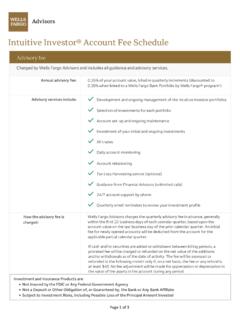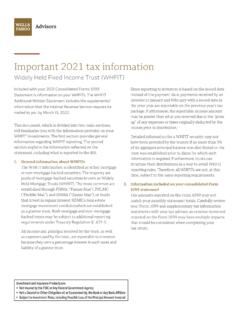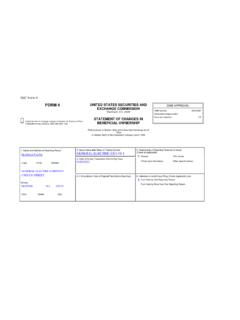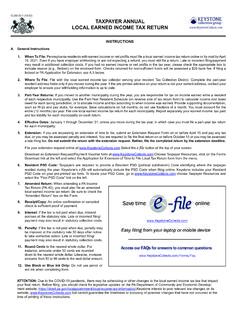Transcription of 2021 tax planning tables - Wells Fargo Advisors
1 12021 tax plannin tables2021 tax planning tables NOT FDIC Insured NO Bank Guarantee MAY Lose ValueInvestment and Insurance Products:1 2 2021 tax planning tables2021 tax planning tables 2021 important deadlines Last day to .. January 15 Pay fourth-quarter 2020 federal individual estimated income tax January 27 Buy in to close a short-against-the-box position (regular-way settlement) for 2020 April 15 Pay first-quarter 2021 federal individual estimated income tax May 17* File 2020 federal individual income tax return (or make payment with extension) Make 2020 contribution to traditional IRA, Roth IRA, Health Savings Account (HSA), or Education Savings Account (ESA)
2 June 15 Pay second-quarter 2021 federal individual estimated income tax September 15 Pay third-quarter 2021 federal individual estimated income tax October 15 File 2020 federal individual income tax return subject to automatic extensions November 30 Double up to avoid violating the wash sale rule December 31 Sell stock or listed options to realize a gain or loss Take 2021 RMDs from traditional IRAs and most qualified plans if you reached age 72 before 2021 Complete a Roth IRA conversion Complete a 529 plan contribution Sell shares acquired through the 2021 exercise of incentive stock options (ISOs) in disqualifying disposition to limit Alternative Minimum Tax (AMT) exposure Complete gifts for the current calendar year (charitable or other) * Revised March 2021 due to subsequent IRS guidance 3 4 2021 tax planning tables2021 tax planning tables Married taxpayer filing separately 2021 income tax rate schedules* If taxable income is: The tax is: $0 $9,950 10% of the taxable income $9,950 $40,525 $ + 12% of excess over $9,950 Married taxpayer filing jointly/surviving spouse If taxable income is: The tax is.
3 $0 $19,900 $19,900 $81,050 $81,050 $172,750 $172,750 $329,850 $329,850 $418,850 $418,850 $628,300 $628,300 or more 10% of the taxable income $1, + 12% of excess over $19,900 $9, + 22% of excess over $81,050 $29, + 24% of excess over $172,750 $67, + 32% of excess over $329,850 $95, + 35% of excess over $418,850 $168, + 37% of excess over $628,300 Single Taxpayer If taxable income is: The tax is: $0 $9,950 $9,950 $40,525 $40,525 $86,375 $86,375 $164,925 $164,925 $209,425 $209,425 $523,600 $523,600 or more 10% of the taxable income $ + 12% of excess over $9,950 $4, + 22% of excess over $40,525 $14, + 24% of excess over $86,375 $33, + 32% of excess over $164,925 $47, + 35% of excess over $209,425 $157, + 37% of excess over $523,600 Head of household If taxable income is: The tax is.
4 $0 $14,200 10% of the taxable income $14,200 $54,200 $1, + 12% of excess over $14,200 $54,200 $86,350 $6, + 22% of excess over $54,200 $86,350 $164,900 $13, + 24% of excess over $86,350 $164,900 $209,400 $32, + 32% of excess over $164,900 $209,400 $523,600 $46, + 35% of excess over $209,400 $523,600 or more $156, + 37% of excess over $523,600 $40,525 $86,375 $4, + 22% of excess over $40,525 $86,375 $164,925 $14, + 24% of excess over $86,375 $164,925 $209,425 $33, + 32% of excess over $164,925 $209,425 $314,150 $47, + 35% of excess over $209,425 $314,150 or more $84, + 37% of excess over $314,150 * Taxable income is income after all deductions (including either itemized or standard deduction).
5 Standard deductions Married/ joint Single Head of household Married/ separate Dependents $25,100 $12,550 $18,800 $12,550 $1,100 For dependents with earned income, the deduction is the greater of $1,100 or earned income + $350 (up to $12,550). Additional standard deductions Married, age 65 or older or blind Married, age 65 or older and blind Single, age 65 or older or blind Single, age 65 or older and blind * per person$ 1,350* $2, 700* $ 1,700 $3, 400 5 6 2021 tax planning tables2021 tax planning tables Capital gains and losses and dividends Long-term capital gain rate (longer than one year) 0%* 15%* 20%* Single $0 $40,400 $40,401 $445,850 $445,851 + Married filing jointly and surviving spouse $0 $80,800 $80,801 $501,600 $501,601 + Head of household $0 $54,100 $54,101 $473,750 $473,751 + Married filing separately $0 $40,400 $40,401 $250,800 $250,801 + Trusts and estates $0 $2,700 $2,701 $13,250 $13,251 + *Determine y our capital gain bracket by adding your net long-term capital gains and/ or qualified dividends to your other taxable income net of deductions.
6 For example, assume a joint filer has net taxable income of $85,000 which includes $20,000 in net long-term capital gain. The first $15,800 of the gain falls within the 0% rate threshold of $80,800 and will be taxed at 0%; while the remaining $4,200 of long-term capital gain is above the $80,800 threshold and will be taxed at 15%. Short-term capital gain rate (one year or less) Taxed at ordinary income tax rate. Dividends Qualified dividends are taxed at the long-term capital gain rates. Nonqualified dividends are taxed at ordinary income tax rates. Higher rates apply to collectibles and unrecaptured 1250 gain. Consult your tax advisor about how they apply to your situation.
7 Netting capital gains and losses 1. Net short-term gains and short-term losses. 2. Net long-term gains and long-term losses. 3. Net short-term against long-term. 4. Deduct up to $3,000 of excess losses against ordinary income per year. 5. Carry over any remaining losses to future tax years Alternative Minimum Tax (AMT) Tax brackets AMT income Tax Up to $199,900* Over $199,900 * $99,950 if married filing separately 26% 28% AMT exemption Exemption Phased out on excess over Married filing joint and surviving spouse $114,600 $1,047,200 Unmarried individual $73,600 $523,600 Married filing separately $57,300 $523,600 Trusts and estates $25,700 $85,650 Education planning Education Savings Accounts (ESA) Maximum nondeductible contribution is $2,000 per child, per year.
8 Maximum contribution amount is lowered if a contributor s modified adjusted gross income (MAGI) is between: $95,000 and $110,000 for individual filers $190,000 and $220,000 for joint filers No contributions can be made if contributor s MAGI exceeds the stated limits or the beneficiary is age 18 or older. Interest, dividends, and capital gains grow tax-deferred and may be distributed federal-income-tax free as long as the money is used to pay qualified education expenses. 7 8 2021 tax planning tables2021 tax planning tables 529 plans Earnings accumulate tax-deferred; qualified withdrawals may be federal-income-tax-free. State-tax incentives available in some states.
9 Contributions up to $75,000 (single) and $150,000 (married couples) allowed in one year without a reduction in the applicable gift/estate tax exclusion (see page 14). No additional gifting in the current year or next four years without incurring potential gift tax implications. Please consider the investment objectives, risk, charges, and expenses carefully before investing in a 529 savings plan. The official statement for a specific plan, which contains this and other information, can be obtained by calling your financial advisor . Read it carefully before you invest. American Opportunity Credit $2,500 per student for first four Maximum credit years of qualified expenses paid MAGI phaseouts: Married filing jointly $160,000 $180,000 Single filer $80,000 $90,000 Lifetime Learning Credit 20% of first $10,000 (per tax return) of qualified expenses paid in 2021 Maximum credit MAGI phaseouts: Married filing jointly $160,000 $180,000* Single filer $80,000 $90,000* *Revised January 2021 due to subsequent legislation.
10 Exclusion of Savings Bond interest MAGI phaseouts: Married filing jointly $124,800 $154,800 Others $83,200 $98,200 Bonds must be titled in name(s) of taxpayer(s) only. Owner must be age 24 or older at time of issue. Must be Series EE issued after 1989 or any Series I bonds. Proceeds must be used for qualified postsecondary education expenses of the taxpayer, spouse, or dependent. Student loan interest deduction Maximum deduction $2,500 MAGI phaseouts: Married filing jointly $140,000 $170,000 Others $70,000 $85,000 Kiddie tax Children who have not reached the age of 19 by the end of the tax year are subject to the kiddie tax rules. If the child continues to be a full-time student, the rules apply until he or she turns age 24.












